 Northside of Thornburg Avenue (now Ivenson Ave.),
looking west from 2nd Street toward Union Pacific Hotel and Depot, 1907.
Compare with the 1913 photo below. The building on the corner is the Laramie Drug Co. which had, among other things a soda fountain.
The drug store advertised that it was
a "Stork Store." Stork stores participated in the "Stork System of Savings" which was popular in parts of the American
West from about 1911 to 1930. Under the Stork System the parent of a child under the age of five would through a participating
store open a savings account in the child's name with the designated Stork Depository with a dollar provided by the store. For each purchase made by the parents,
relatives or friends of the child, the store would issue script in the amount of five per cent of the purchase. The script could then be
taken to the depository bank which would then give full credit for the script in the savings account passbook. The account, thus,
would accumulate the savings and the interest on the account until the child reached the age of
fifteen when the child could withdraw it for his or her education. The advantage to the merchant is that only one store of each
type was authorized to participate in any one town and only one bank would be designated. Particpating
merchants in Laramie were Gen City Grocery, Drew clothing, Laramie Coal Co., the Grand Ave. Market, the Boston Store, and Laramie Drug. The bank was the
First State Bank. In Cheyenne, participating merchants were the Ingersoll Store, Bon Shoe and Clothin, A. E. Roedel Druggest, and the Union
Mercantile Co. Further down the street was the Derby Saloon and the Peterson Taylor Shop.
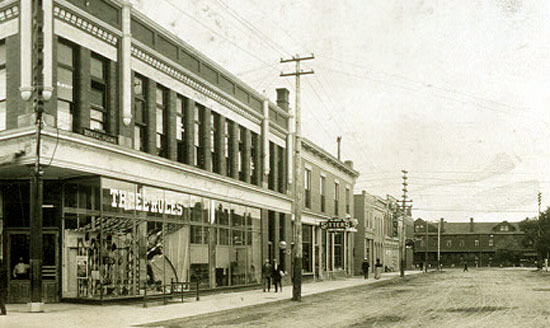
Southside of Thornburg Avenue (now Ivenson Ave.), looking west from 2nd Street
toward
the Union Pacific Hotel and Depot, Laramie,
1907.
The building on the corner with the sign "Three Rules" is the "Miller Block" housing the Gish Hunter Mercantile Co. The next building was
a saloon. At various times it was the Derby Bar, Blair & McCune's and the
Hub. With the coming of prohibition it became a barbership. It now houses the
Buckhorn Saloon discussed on the next page. In the next block is the Kuster Hotel.
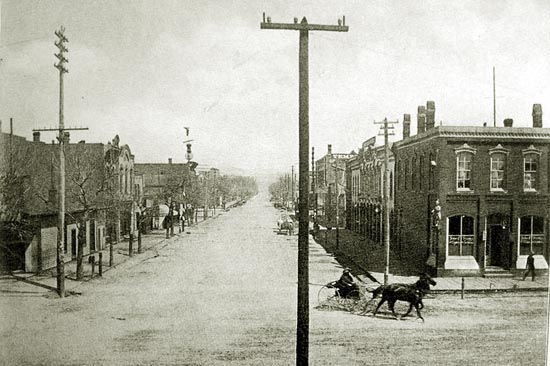
Thornburg Avenue (now Ivenson Ave.), looking east from the Union
Pacific Hotel, approx. 1902.
The second building on the right is The Kuster hotel originally constructed in 1869 at a cost of $5,000.00.
It was renovated and expanded in 1890. Across the street is the Phillips Hotel constructed in 1889. See text next page.
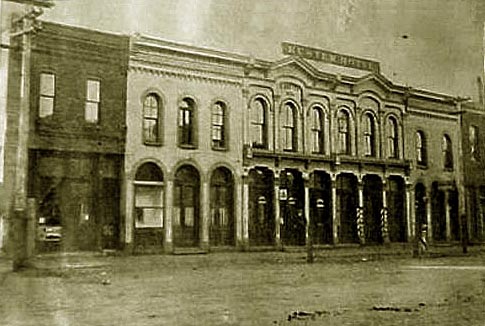
Kuster Hotel, 1905.
The building which housed the Kuster Hotel is still in existence but its facade had been redone.
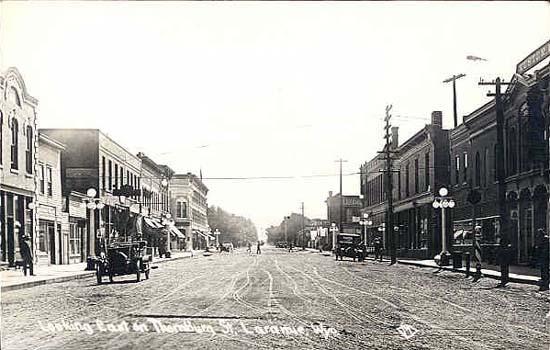
Thornburg Ave. looking east from Front Street, approx 1913.
The first building on the left is the Phillips Hotel (see text below), the upper floor of
which was reputedly used for sporting purposes. The first building on the
right with the sign on the roof is the Kuster Hotel.
The building on the right, past the lamppost, now houses the Buckhorn. The building on the
left side of the street with the diagonal entrance
in the next block is the First National Bank constructed by Edward Ivinson. Beyond the bank is the
Converse Building.
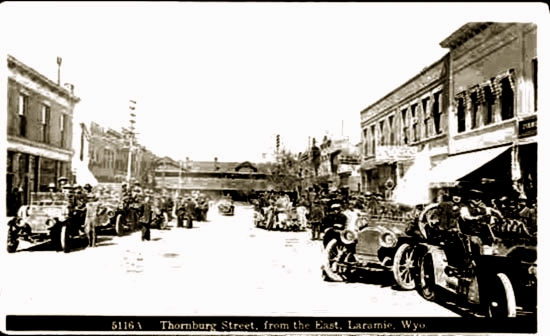
Thornburg (now Ivinson Ave.) looking west from Second Street toward Union Pacific Hotel on
Front Street, approx. 1913.
Compare scene with topmost photo and note that the buildings to the west of the drugstore (not in picture) have been replaced.
On May 16, 1907, patrons of the Kuster hotel observed flames coming from Peterson's Tailor shop. A telephone call was made to the
Fire Department. Additionally, the call box at the corner of Thornburg and 2nd Street was activated. Altough, the fire department arrived within
five minutes, the fire was shortly out of control. The headlines the next morning in the Daily Boomerang indicated the disaster:
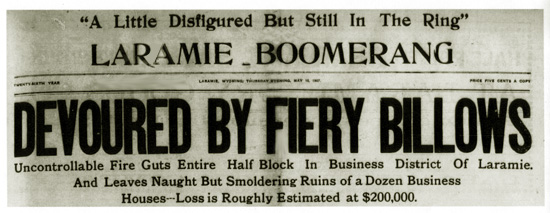
Headline, Laramie Boomerang, May 17, 1907.
The fire extended from Thornburg north to University and from 2nd Street to the alley. Businesses destroyed included
Kingford's Cigar Store, Peterson's Tailor Shop, Eggleston's cigar store, Miller's jewelry store, Carter's jewelry, the Home Restarant, ,
the Boomerang office and job room, Crawford's second-hand store, and Lockwood's taxidermy. There was smoke and water damage to Laramie
Drug and the Derby Saloon. The heat broke windows on the Miller Block, ignited awnings across the street on Second Street, and melted
part of the cornice on the City Hall. The Boomerang the next day indicated, however, that the monitary damage was not as great
as it thought in the heat of the moment when it was doing the composing as the flames approached its offices.
Next Page: Ivinson continued, The Buckhorn.
|